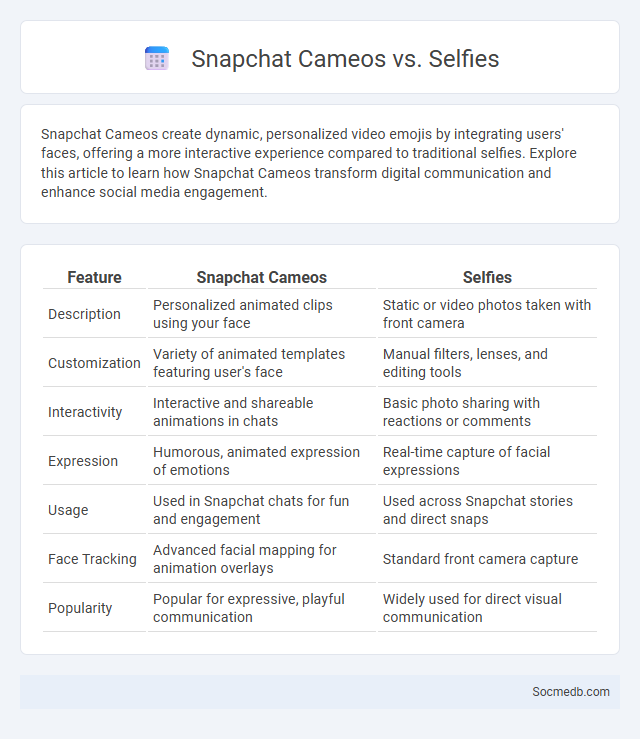
Photo illustration: Snapchat Cameos vs Selfies
Snapchat Cameos create dynamic, personalized video emojis by integrating users' faces, offering a more interactive experience compared to traditional selfies. Explore this article to learn how Snapchat Cameos transform digital communication and enhance social media engagement.
Table of Comparison
| Feature | Snapchat Cameos | Selfies |
|---|---|---|
| Description | Personalized animated clips using your face | Static or video photos taken with front camera |
| Customization | Variety of animated templates featuring user's face | Manual filters, lenses, and editing tools |
| Interactivity | Interactive and shareable animations in chats | Basic photo sharing with reactions or comments |
| Expression | Humorous, animated expression of emotions | Real-time capture of facial expressions |
| Usage | Used in Snapchat chats for fun and engagement | Used across Snapchat stories and direct snaps |
| Face Tracking | Advanced facial mapping for animation overlays | Standard front camera capture |
| Popularity | Popular for expressive, playful communication | Widely used for direct visual communication |
Understanding Snapchat Cameos: A Brief Overview
Snapchat Cameos allow users to create personalized, looping video avatars by overlaying their facial expressions onto various animated scenes, enhancing interactive communication. This feature leverages advanced facial recognition technology to capture and map user expressions in real time, providing a unique way to share emotions or reactions in chats. Integrating seamlessly within Snapchat's messaging interface, Cameos boost user engagement by offering a fun, customized visual experience that differentiates the platform from other social media apps.
What Are Selfies? Evolution and Popularity
Selfies are self-portrait photographs typically taken with a smartphone or digital camera, capturing an individual's face or full body to share on social media platforms like Instagram and Snapchat. The evolution of selfies began with early camera phones in the early 2000s and surged in popularity with the rise of front-facing cameras and user-friendly apps, making self-expression and digital identity more accessible. Social media ecosystems amplify selfie culture, driving trends, influencing social interactions, and shaping online personal branding.
Defining Snapchat Cameos: Key Features
Snapchat Cameos enable users to create short, personalized looping videos featuring their own facial expressions superimposed on popular GIFs and scenes. These animations use facial recognition technology to seamlessly integrate user selfies, enhancing engagement and offering a unique form of self-expression. The key features include easy sharing within chats, customizable Cameo styles, and an extensive library of templates for diverse emotions and reactions.
Cameos vs Selfies: Core Differences
Cameos involve personalized video messages from celebrities, creating unique, engaging content distinct from selfies, which are self-captured images or videos shared on social media platforms. While selfies emphasize personal expression and instant sharing, cameos offer curated, professional interactions that enhance user engagement through celebrity endorsement. The core difference lies in content origin--user-generated versus celebrity-produced--impacting authenticity, reach, and marketing potential across platforms like Instagram, TikTok, and Cameo.
How Snapchat Cameos Work: Step-by-Step
Snapchat Cameos allow users to create personalized looping videos by placing their faces onto animated characters. To create a Cameo, users first capture a selfie within the Snapchat app, which is then automatically inserted into various animated templates available in the Cameos tab. These customized clips can be sent in chats, making conversations more expressive and fun by incorporating the user's facial expressions into humorous or thematic scenarios.
Visual Creativity: Filters, Stickers, and Expressions
Visual creativity on social media thrives through the dynamic use of filters, stickers, and expressive tools that enhance user engagement and content appeal. Filters alter color tones and moods, transforming ordinary photos into captivating visuals, while stickers add personality and context, boosting interaction rates. Expressive elements like emojis and animated effects convey emotions effectively, making posts more relatable and shareable across platforms like Instagram, Snapchat, and TikTok.
Social Engagement: Sharing Cameos vs Selfies
Social engagement on social media varies significantly between sharing cameos and selfies, with cameos often fostering more authentic interactions due to their dynamic and context-rich content. Research indicates that cameos, which capture real-time emotions and collaborative moments, receive higher comment rates and longer viewer retention compared to static selfies. Brands leveraging cameos in campaigns report increased user participation and stronger community building, highlighting their effectiveness in enhancing social connection and engagement metrics.
Privacy and Security: User Concerns
Social media platforms must address privacy and security concerns as data breaches and unauthorized access increasingly threaten user information. Your personal data, including location, messages, and browsing habits, can be exploited if privacy settings are not properly managed or if platforms lack robust encryption. Ensuring strong password protocols, regular updates, and awareness of phishing scams protects your digital presence in an evolving cyber threat landscape.
Use Cases: When to Use Cameos vs Selfies
Cameos excel in personalized marketing, allowing brands to integrate celebrity or influencer videos for enhanced engagement and targeted promotion. Selfies serve best for authentic, user-generated content that fosters direct connection and relatability with audiences on platforms like Instagram and Snapchat. Employ cameos to boost campaign visibility through recognizable faces, while selfies are ideal for spontaneous, organic interactions that build community trust.
Future of Digital Self-Representation on Snapchat
Snapchat is pioneering the future of digital self-representation through advanced augmented reality (AR) filters and Bitmoji avatars that enable users to create highly personalized and immersive identities. The platform's investment in AI-driven customization tools allows for dynamic expression, reflecting real-time emotions and styles, thereby transforming social interactions. Continued innovation in privacy-focused features ensures users maintain control over their digital personas, setting new standards in authentic and secure self-presentation online.
 socmedb.com
socmedb.com